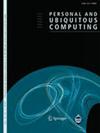Automation of interaction—interaction design at the crossroads of user experience (UX) and artificial intelligence (AI)
Q1 Social Sciences
引用次数: 0
Abstract
Abstract Interaction design/HCI seems to be at a crossroads. On the one hand, it is still about designing for engaging user experiences (UX). Still, on the other hand, it seems to be increasingly about reducing interaction and automating human–machine interaction through the use of AI and other new technologies. In this paper, we explore this seemingly unavoidable gap. First, we discuss the fundamental design rationality underpinning interaction and automation of interaction from the viewpoints of classic theoretical standpoints. We then illustrate how these two come together in interaction design practice. Here we examine four examples from already published research on automation of interaction, including how different levels of automation of interaction affect or enable new practices, including coffee making, self-tracking, automated driving, and conversations with AI-based chatbots. Through an interaction analysis of these four examples, we show (1) how interaction and automation are combined in the design, (2) how interaction is dependent on a certain level of automation, and vice versa, and (3) how each example illustrates a different balance between, and integration of interaction and automation. Based on this analysis, we propose a two-dimensional design space as a conceptual construct that takes these aspects into account to understand and analyze ways of combining interaction and automation in interaction design. We illustrate the use of the proposed two-dimensional design space, discuss its theoretical implications, and suggest it as a useful tool—when designing for engaging user experiences (UX), with interaction and automation as two design materials.

交互自动化——用户体验(UX)和人工智能(AI)交叉的交互设计
交互设计/HCI似乎正处于十字路口。一方面,它仍然是关于吸引用户体验(UX)的设计。然而,另一方面,通过使用人工智能和其他新技术,似乎越来越多地减少交互和自动化人机交互。在本文中,我们探讨了这个看似不可避免的差距。首先,我们从经典的理论立场出发,讨论了支撑交互和交互自动化的基本设计合理性。然后我们说明这两者在交互设计实践中是如何结合在一起的。在这里,我们从已经发表的关于交互自动化的研究中选取了四个例子,包括不同程度的交互自动化如何影响或实现新的实践,包括咖啡制作、自我跟踪、自动驾驶和与基于人工智能的聊天机器人的对话。通过对这四个示例的交互分析,我们展示了(1)交互和自动化如何在设计中结合,(2)交互如何依赖于一定程度的自动化,反之亦然,以及(3)每个示例如何说明交互和自动化之间的不同平衡和集成。在此基础上,我们提出了一个二维的设计空间,作为一个考虑到这些方面的概念结构,以理解和分析交互设计中交互与自动化相结合的方式。我们说明了所提出的二维设计空间的使用,讨论了它的理论含义,并建议它作为一种有用的工具-当设计引人入胜的用户体验(UX)时,交互和自动化是两种设计材料。
本文章由计算机程序翻译,如有差异,请以英文原文为准。
求助全文
约1分钟内获得全文
求助全文
来源期刊

Personal and Ubiquitous Computing
工程技术-电信学
CiteScore
6.60
自引率
0.00%
发文量
35
审稿时长
6-12 weeks
期刊介绍:
Personal and Ubiquitous Computing publishes peer-reviewed multidisciplinary research on personal and ubiquitous technologies and services. The journal provides a global perspective on new developments in research in areas including user experience for advanced digital technologies, the Internet of Things, big data, social technologies and mobile and wearable devices.
 求助内容:
求助内容: 应助结果提醒方式:
应助结果提醒方式:


